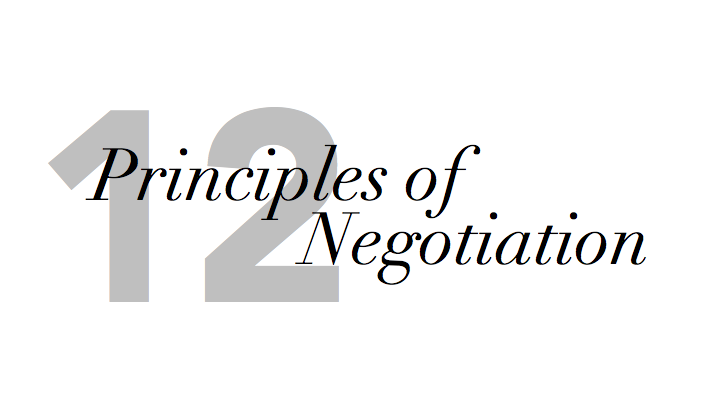Twelve Principles for Negotiating with Clients

1. Recognize your right to negotiate. Assume that negotiation is part of freelancing. When called about a job, express an interest in the proposed project and its terms, but don’t feel compelled to accept the whole package immediately.
2. Select the time for negotiation. Allow negotiating to take a little time, often more than one conversation and sometimes more than one day. Clients often need to check with their supervisors: stay calm. If a call comes at a bad time, don’t hesitate to offer to call back at a specified time (but always do so). Rather than negotiating without your full attention, you’ve shown that you’re in control of your time and concentration.
3. Set a tone favorable to negotiation. Create a positive attitude toward negotiating. Indicate a willingness to meet the client’s needs, if the client’s principal goals don’t conflict with your own. Express interest in what the client says. Listen carefully. Be interested, positive, upbeat about the proposed project. Ask questions before committing yourself to a job or its terms. In the process, you’re making the client invest some time in you, and you’re creating a chance to inspire confidence in your work.
4. Research the party with whom you are negotiating. Find out all you can about a client. Ask other Association members (this is a good time to use the Discussion Board). You might discover that a client has routinely paid more than you had expected; such information should give you the confidence you might need to ask for what you want.
5. Know yourself. Before you proceed with negotiating, determine your maximum and minimum goals. These might, for example, include minimum acceptable and optional rates, your personal schedule limitations, or a clearly defined scope for the project (such as rewriting vs. limited copyediting).
6. Analyze the negotiating problem. Review negotiable issues when taking a project. This process clarifies the client’s expectations and often identifies areas in which negotiating is needed (for example, rates, schedules, reimbursement for expenses, scope of work to be done, travel). Be aware of the interdependence of negotiable issues (for example some clients will pay more for a fast turnaround).
7. Assess the client’s probable and actual needs, both before and during negotiation. Determine what the client wants most (for example, schedule guarantees, diplomacy with authors, freelancers who can work without much supervision). Identify those needs that you can readily meet. Be flexible as you learn more from the client about these needs. Ask questions to clarify.
8. Don’t sell yourself short. Don’t ask for the minimum requirements as you’ve framed them. Ask for larger goals, but indicate a willingness to negotiate if necessary. Express surprise (although positively) if a client refuses to negotiate or reach an agreement acceptable to you. Pause. Repeat the offer, letting the client know that others have found it acceptable.
9. Make strategic concessions. Your concessions should move negotiation toward an agreement that takes account of your bottom line. Flag your concession for the client and request a good-faith offer in return.
10. Know when to say no. Be prepared to say no if your minimum goals aren’t met. (Fallback positions that compromise some but not all of your goals are acceptable only as long as they fall between your minimum and maximum goals.)
11. Build your relationship to the client. Emphasize a willingness to take responsibility for the client’s needs. Repeating what the client wants helps your credibility (for example, “I’ll call you as soon as I’ve assessed the project, and I’ll be sure the authors are treated with kid gloves”).
12. Summarize your agreement with the client.

